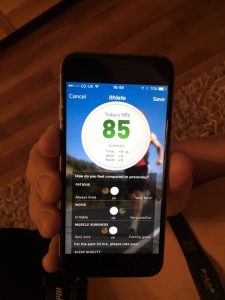 My name is Richard Beck and I am currently studying for a Masters in Strength & Conditioning from St Mary’s University, Twickenham. Over the coming months, I will be writing three blog posts for the ithlete website as I complete my dissertation.
My name is Richard Beck and I am currently studying for a Masters in Strength & Conditioning from St Mary’s University, Twickenham. Over the coming months, I will be writing three blog posts for the ithlete website as I complete my dissertation.
- Covering the title of my dissertation as well as the methodology and objectives behind it.
- A look at how data collection is going and offer practical tips for those looking to either collect data themselves or do something similar with their own team.
- Finally reporting back with my findings for the last blog.
It is probably worth introducing myself briefly before moving on to look at my dissertation in more detail. Away from studying, I currently play rugby union professionally for Yorkshire Carnegie in the Greene King IPA Championship. I have played with Carnegie for over ten years after coming through the academy system. In recent years, I have also taken up coaching and currently coach Harrogate RUFC. Rugby has been a passion of mine from an early age and the chance to do some research in the area was an opportunity I didn’t want to miss.
The title of my dissertation is “The effect of fluctuations in training load on heart rate variability in elite rugby union players”. What drew me to this idea in particular was the concept of monitoring fatigue. As a rugby player myself, I have been subjected to a number of different muscular, psychological and physiological tests to assess whether I have recovered from training or a match. There is no doubt that monitoring of fatigue is essential in order to avoid overtraining and injury. Indeed, research would suggest between 7% and 50% of high-level athletes show signs of chronic fatigue at any given instant (Naessens, Chandler, Kibler & Driesens, 2000; Kentta, Hassmen & Raglin, 2001). As a result, it is vital to monitor athletes’ fatigue and performance responses to various training and playing periods. Understanding the fatigue response and players’ recovery can help determine training loads to maximise performance (Fowles, 2006). Therefore, selecting the right monitoring tools is hugely important.
As I mentioned previously, a number of different monitoring tools are available to coaches, however, heart rate (HR) continues to be one of the most accessible physiological measures available. HR monitors are now widely available and are relatively cheap in comparison to other monitoring tools such as Global Positioning Systems (GPS). From an athlete’s HR a number of indices can be calculated depending on the equipment and recording conditions. For example, HR, heart rate recovery and heart rate variability (HRV) are linked to parasympathetic and sympathetic activity and can be considered as a marker of homeostasis, as well as providing feedback about cardiovascular recovery following a training session (Stanley, Peake & Bucheit, 2013). Therefore, I wanted to investigate whether HRV fluctuated in response to different training loads and whether it would be a useful tool for rugby coaches in identifying fatigue within their players.
 As part of the study I will be using twenty male Championship rugby players. Waking HRV, training load and wellness parameters will be collected daily for four weeks of the regular season. HRV will be gathered by the players in the morning after waking. It will be collected using a chest-strap transmitter and ithlete smartphone application and receiver. The HRV measure should take place immediately on waking while resting motionless lying on their bed and breathing naturally. By taking the reading immediately upon waking it is thought to limit some of the environmental conditions (e.g., noise, light and temperature) which the autonomic nervous system is sensitive to (Achten & Jeukendrup, 2003). After the subjects have completed their HRV recording, they will complete a brief questionnaire using the ithlete app (McLean, Coutts, Kelly, McGuigan & Cormack, 2010). The questionnaire will be made up of questions about the subject’s sleep quality, muscle soreness, mood, fatigue and stress. It is important to take this into consideration because cardiac-autonomic activity is sensitive to a number of physical and psychological stressors which could make the relationship between training load and HRV difficult to see (Tian et al., 2012).
As part of the study I will be using twenty male Championship rugby players. Waking HRV, training load and wellness parameters will be collected daily for four weeks of the regular season. HRV will be gathered by the players in the morning after waking. It will be collected using a chest-strap transmitter and ithlete smartphone application and receiver. The HRV measure should take place immediately on waking while resting motionless lying on their bed and breathing naturally. By taking the reading immediately upon waking it is thought to limit some of the environmental conditions (e.g., noise, light and temperature) which the autonomic nervous system is sensitive to (Achten & Jeukendrup, 2003). After the subjects have completed their HRV recording, they will complete a brief questionnaire using the ithlete app (McLean, Coutts, Kelly, McGuigan & Cormack, 2010). The questionnaire will be made up of questions about the subject’s sleep quality, muscle soreness, mood, fatigue and stress. It is important to take this into consideration because cardiac-autonomic activity is sensitive to a number of physical and psychological stressors which could make the relationship between training load and HRV difficult to see (Tian et al., 2012).
The quantification of training load is a vital step in understanding the link between training and competition and the fatigue response within athletes. An athlete’s perception of effort is a valid tool for assessing exercise intensity and when multiplied by training duration in minutes, can represent the internal load of the training session (Foster et al., 2001). Session rating of perceived exertion (s-RPE) has been validated in team sports with internal training load measures of HR and blood lactate providing strong relationships with s-RPE (Alexiou & Coutts, 2008; Impellizzeri, Rampinini, Coutts, Sassi & Marcora, 2004). The advantages of collecting training load in this way is that it is simple, cheap and non-invasive. Subjects will record their RPE within 15-30 minutes after each training session. The RPE will then be multiplied by session duration (min) to give a s-RPE. All the s-RPE for each day will then be added together to give a total training load for that day.
Considering the effect of daily training and matches on HRV could give coaches vital physiological information, and when combined with other monitoring tools could guide player recovery and future training loads. Additional research into daily HRV responses to rugby training and matches is required to establish whether HRV has a practical use for rugby teams. I hypothesised that changes in training load would relate to changes in HRV and in particular a substantial reduction in HRV following a game day.
I am looking forward to starting the data collection although reminding twenty rugby players to do this every morning for a month may be the biggest challenge.
Wish me luck!
References
Achten, J., & Jeukendrup, A. E. (2003). Heart rate monitoring. Sports Medicine, 33(7), 517-538.
Alexiou, H., & Coutts, A. J. (2008). A comparison of methods used for quantifying internal training load in women soccer players. International Journal of Sports Physiology and Performance, 3(3), 320-330.
Foster, C., Florhaug, J. A., Franklin, J., Gottschall, L., Hrovatin, L. A., Parker, S., … & Dodge, C. (2001). A new approach to monitoring exercise training. The Journal of Strength and Conditioning Research, 15(1), 109-115.
Fowles, J. R. (2006). Technical issues in quantifying low-frequency fatigue in athletes. International Journal of Sports Physiology and Performance, 1(2), 169-171.
Impellizzeri, F. M., Rampinini, E., Coutts, A. J., Sassi, A. L. D. O., & Marcora, S. M. (2004). Use of RPE-based training load in soccer. Medicine & Science in Sports & Exercise, 36(6), 1042-1047.
Kenttä, G., Hassmén, P., & Raglin, J. S. (2001). Training practices and overtraining syndrome in Swedish age-group athletes. International Journal of Sports Medicine, 22(06), 460-465.
McLean, B. D., Coutts, A. J., Kelly, V., McGuigan, M. R., & Cormack, S. J. (2010). Neuromuscular, endocrine, and perceptual fatigue responses during different length between-match microcycles in professional rugby league players. International Journal of Sports Physiology and Performance, 5(3), 367-383.
Naessens, G., Chandler, T. J., Kibler, W. B., & Driessens, M. (2000). Clinical Usefulness of Nocturnal Urinary Noradrenaline Excretion Patterns in the Follow-Up of Training Processes in High-Level Soccer Players. The Journal of Strength & Conditioning Research, 14(2), 125-131.
Stanley, J., Peake, J. M., & Buchheit, M. (2013). Cardiac parasympathetic reactivation following exercise: implications for training prescription. Sports Medicine, 43(12), 1259-1277.
Tian, Y., He, Z. H., Zhao, J. X., Tao, D. L., Xu, K. Y., Earnest, C. P., & Mc Naughton, L. R. (2013). Heart rate variability threshold values for early-warning nonfunctional overreaching in elite female wrestlers. The Journal of Strength & Conditioning Research, 27(6), 1511-1519.

As an ithlete user, would find it interesting if you could also look somehow at the usefulness of the training intensity recommendations of ithlete Pro version (if they let your subjects use for free)? Subjectively from own experience it is, and that and convenience draw me to ithlete (otherwise I’d prefer raw data and a tool like Kubios).